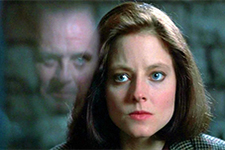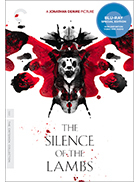The Silence of the Lambs
|  The Silence of the Lambs, an unexpectedly popular and deeply influential horror-thriller that successfully transcended the limitations of its genre and swept the Academy Awards in 1992, has one of the greatest opening acts in cinema history. All of the film's most enduring aesthetic qualities and themes-essentially what sets it apart from so many imitators and established it almost immediately as a canonical film-are contained in those riveting first 20 minutes, which draw you in like a steel trap and hold you transfixed for the ensuing 100 minutes. All aspiring filmmakers, but particularly those who hope to make thrillers, should be required to study these opening moments in depth and commit their every nuance to memory. The film opens with Howard Shore's foreboding, funereal theme music playing over shots of a young FBI trainee named Clarice Starling (Jodie Foster) running through the woods next to the FBI training facility in Quantico, Virginia. This credits sequence, simple though it first appears, establishes a number of important elements, the most important being the centrality of Clarice. While horror films and thrillers frequently feature women, they are more often than not victims rather than heroes, a tendency that The Silence of the Lambs aptly turns on its head. At first, director Jonathan Demme presents Clarice as if she is running from something (a monster of some kind, a knife-wielding killer), a standard-issue horror cliché that he quickly undercuts when we see that she is on an obstacle course and realize that she is running through something, not away from it. Thus, in just the first few moments, Demme and screenwriter Ted Tally (who adapted Thomas Harris's 1988 novel) establish the film's female-centric focus and its willingness to undercut horror expectations, even as it finds particularly exhilarating ways to fulfill them, as well. Clarice is called into the office of Jack Crawford (Scott Glen), the head of the FBI's Behavioral Science division, which is charged with studying and tracking down serial killers. Crawford wants her to interview Dr. Hannibal Lecter, a brilliant psychiatrist-turned-cannibalistic serial killer who has been in captivity for nearly a decade and may be able to provide some information that might help them capture a new serial killer known as "Buffalo Bill" (Ted Levine), who has been kidnapping women and skinning them. In this sequence, Demme continues to emphasize Clarice's inherent dilemma as a woman making her mark in a man's world, most directly in a shot where she steps into an elevator full of male trainees, all of whom are at least six inches taller than she is-a quick, but effective visual metaphor for the challenges she faces. He also establishes the film's most powerful aesthetic device: the use of repeated close-ups in which the characters look directly into the camera, an aggressively intimate approach that will become key to why the film works so well. Demme and editor Craig McKay (who won an Oscar in 1982 for his work on Warren Beatty's Reds) use a darkly amusing transition by ending the scene in Crawford's office with Clarice asking "And what is he?" in reference to Lecter to an establishing shot of the foreboding red-brick Baltimore psychiatric hospital where Lecter is being kept with the voice of the hospital's chief psychiatrist, a squirrelly ego maniac named Dr. Chilton (Anthony Heald), effectively "answering" the question with "Oh, he's a monster." Thus continues the discussion of Lecter, who, of course, we have not seen yet, but has been talked about in such depth that we feel like we have. It's a kind of sick twist on the sequence in Casablanca (1942) where all the characters in the club are talking about Rick, building up to the big reveal of Humphrey Bogart in his white dinner jacket, except the reveal here is a harrowing shot of Lecter (Anthony Hopkins) standing fully erect in the middle of his cell, as if he has somehow sensed Clarice's arrival. In a single moment the film establishes Lecter's powerful and frightening nature, but also the crucial connection he and Clarice come to share. As Tally put it, he's as interested in her as she is in him, which forever binds them in an uneasy, but mutually rewarding connection. But, before Clarice can get to Lecter, she must descend into his lair, as it were, in a brilliantly constructed sequence that takes Clarice from Dr. Chilton's office down to the dank bowels of the hospital. In a series of fluid camera movements and edits, Demme takes Clarice and the viewer into increasingly darker and more frightening spaces, which establishes the film's visual preoccupation with the coexistence of the gothic and the modern (which we see again in a rural funeral home, an urban museum, and, most importantly, Buffalo Bill's dilapidated residence). The descent to Lecter has been described as a Dante-esque descent into hell, but it seems to me to be a descent from the modern to the gothic. While the hospital above is recognizably part of our world, the rough-stone corridor of the cellblock where Lecter resides feels like it was carved out of some twisted medieval imagination, and the fact that we believe so easily in its existence is testament to how fully the film has us wrapped in its spell even before Lecter has a chance to command the screen. The fact that Lecter's dungeon-like cell is protected not by iron bars, but by a thick sheet of Plexiglas serves the functional need to visually connect Lecter and Clarice, but it also reinforces the film's modern/gothic fascination, seamlessly fusing the two visually and thematically. The descent at the Baltimore hospital also reveals the film's claustrophobic fascination with hidden spaces. Throughout the film Demme uses the idea of hidden spaces to unnerve us, to suggest that there are things just beyond our sight and thus beyond our rational understanding. This includes everything from the massive, sprawling labyrinth of underground rooms beneath the seemingly benign Ohio woodframe house where Buffalo Bill does his terrible work, to the hiding of a crucial piece of evidence in a victim's throat. The film had already hinted at this fascination with its depiction of Crawford's office at the FBI headquarters, which is presented as a windowless cinderblock space covered with grisly images of slaughtered, partially skinned women that simultaneously fascinate and repulse (an apt description of the film itself). In many ways, The Silence of the Lambs is about the fear of what's hidden behind what we see every day. The initial conversation between Lecter and Clarice, which is shot almost entirely in close-ups (as are the rest of their conversations), establishes their compelling dynamic, a kind of battle of the minds that betrays in small and subtle ways each character's needs: her need to get information from him in order to save Buffalo Bill's most recent victim and his need to probe her mind, to see what makes her tick. As played by Anthony Hopkins in one of the truly great roles, Lecter is frightening because he is constantly coiled. He doesn't have to move much to convey great power and threat, and the manner in which Hopkins's hair is slicked back against his head makes him look both fiercely intelligent and vaguely skull-like. Like the film itself, he both fascinates and repulses, and as Clarice tries to interrogate him, we can see her growing and evolving, an important theme that is underlined by the film's use of the "death head" moth as the key to capturing Buffalo Bill. Thus, the opening 20 minutes establish virtually everything that is great about the film as a whole, and what makes it so incessantly memorable is the fact that it builds on those opening moments, intensifying them and drawing them out in continually fascinating ways. The relationship between Lecter and Clarice continues to grow, culminating in an exchange of "quid pro quo" while Lecter is locked in a giant cage inside a Memphis museum. Demme, who was then known primarily as a director of self-consciously retro comedies like Something Wild (1986) and Married to the Mob (1988), is fearless in his direction, and he devises two truly outstanding setpieces at the end of the film, one being Lecter's gruesome escape and the other being Clarice's eventual discovery of Buffalo Bill and her pursuit of him into the darkness of his underground lair. These sequences build on and explode all of our expectations, and they remain pinnacles of thriller filmmaking. Yet, The Silence of the Lambs remains in our minds not only because it frightens, but because it probes and penetrates, tickling our minds while also making our hearts race.
Copyright © 2018 James Kendrick Thoughts? E-mail James Kendrick All images copyright © The Criterion Collection | |||||||||||||||||||||||||||||||
Overall Rating: 


 (4)
(4)


